
|
Home
| pfodApps/pfodDevices
| WebStringTemplates
| Java/J2EE
| Unix
| Torches
| Superannuation
| CRPS Treatment
|
| About
Us
|

|
pfodWeb
|
by Matthew Ford 22nd October 2025 (originally posted 27th August
2025)
© Forward Computing and Control Pty. Ltd. NSW
Australia
All rights reserved.
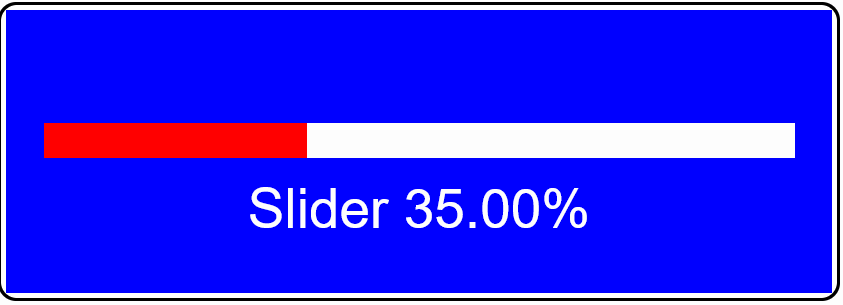
This is the fourth tutorial on using pfodWeb Designer to create
interactive and responsive GUI for pfodApp
and the free, open source, pfodWeb.
This
tutorial will cover touchActionInputs which when triggered popup a
single line text input dialog to allow the user to send text/numberic
data to the pfodDevice (microprocessor)
Your micro serves all the
necessary code to run the web page controls. No third party js
libraries or internet access is needed.
pfodWeb
is a free web based partial
replacement for the paid Android app, pfodApp.
pfodWeb runs in a browser and connects to your Arduino board via
either Serial or BLE or HTTP. Using Serial you can connect to any
Arduino board and display the interactive controls it serves. pfodWeb
runs competely off-line. No internet connection is needed. Just
install the pfodParser library and open the index.html in the pfodWeb
sub-directory of the pfodParser library. The interactive controls are
completely defined by the code (generated by pfodWebDesigner) in your
Arduino. Very compact pfod
messages are used to send the controls and receive the user's
commands.
If your Arduino board supports HTTP and has a file
system of 200Kb, then you can load the all pfodWeb files onto your
microprocessor and serve them directly from there.
pfodWebDesigner is a free web based replacement for the free Android app, pfodGUIdesigner. pfodWebDesigner allows you to design interactive and responsive user interfaces for your microprocessor. pfodWebDesigner generates Arduino code that works with all pfodDevices that connect via Serial, Bluetooth, BLE, SMS and WiFi, not just those that have WiFi support. See how to install pfodWebDesigner and Using pfodWeb Designer to Create GUI's. Individual pfodWebDesigner controls are stored as JSON files which you can duplicate, modify and reuse in other designs. Each reused control can be individually scaled and positioned in the final design.
Introductory
Tutorial – Covers setting up the pfodWeb
Designer local server and install the pfodWeb support on an ESP32. A
simple press button example illustrates touchZone and
touchAction.
Reuse
Controls with insertDwg – Covers copying dwgs
and using insertDwg to insert multiple copies into the main
drawing.
touchActions
for Instant Feedback – Covers
using touchActions to give instant feedback in a slider
control.
TouchActionInput for text/number
entry – This one. Covers using touchActionInput to
input text / numbers to your micro
Building
Reusable Controls – Covers
building a re-usable popup help button component.
pfodWeb is free and open source. If you want to support this work,
purchase the Android pfodApp
which will work with the same code developed here and which provides
more features such as charting and data logging.
See the free
pfodDesigner
Android app for creating menus and charts for pfodApp.
See the Introductory Tutorial for the parts list and the Installation instructions. Physical parts consist of just an Arduino board, e.g. Dfrobot ESP32 board or other Arduino board. (An UNO does not have enough memory to run these examples)
touchActionInput is linked to a
touchZone. When the touchZone is triggered, the single line Dialog
box opens. The title of the dialog box and the initial text displayed
is configurable from your pfodDevice (your microprocessor).
From
the dialog box you can either Cancel or OK. If you Cancel the dialog
box nothing is set to the pfodDevice and no touchActions are
triggered.
If you OK the dialog box, then the input is sent to the
pfodDevice and any touchActions for that touchZone are displayed
until there is a response from the pfodDevice.
The minimal touchActionInput opens with a blank input. If you link
the touchActionInput to a label, the current contents of the that
label are used as the initial value for the dialog input. This lets
you edit an existing label.
As was covered in previous tutorials,
labels (and values) can have prefix and suffix text which will also
be displayed in the dialog box. To edit just a numeric value, add
another label that holds just the current numeric value and then hide
that label. The touchActionInput can still access a hidden label as
its default input and the pfodDevice can update both the hidden label
and the displayed label with the updated value.
This tutorial extends the Slider example of the previous tutorial
to add a touchActionInput that accesses a hidden label which lets you
type in the required slider % and on OK updates the slider, the main
label and the hidden label.
Open pfodWebDesigner and load the
Slider.json from the previous tutorial and make a copy of it called
SliderInput
By default, pfodWebDesigner allocates idx and cmd variable names like idx_1, idx_2 … and cmd_1, cmd_2 … But you can enter your own descriptive names to make the code more readable.
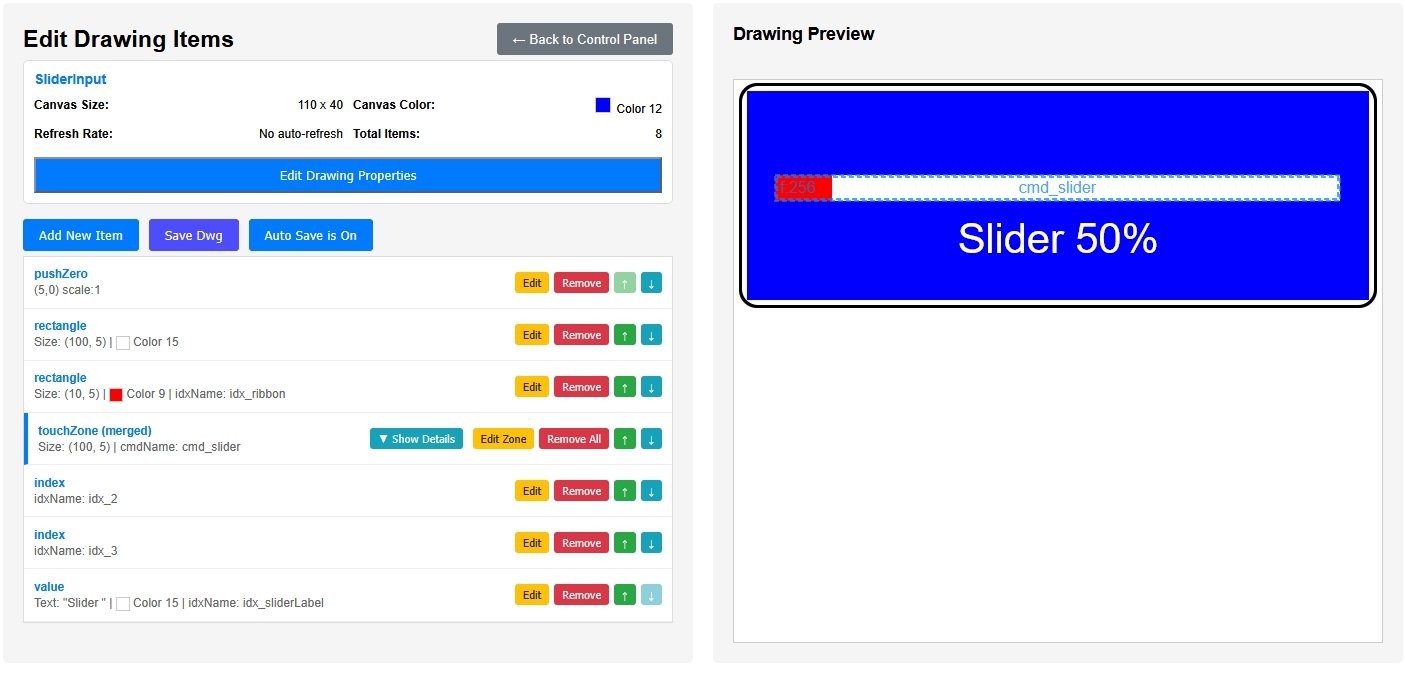
Like idx_ribbon, cmd_slider and
idx_sliderLabel.
Note: The idx_ and cmd_ prefix is not
required
Edit the Drawing Item Value “Slider “ and
change it to a Label with 2 decimal places. Value items
only accept integers and here the slider percent setting will allow
decimal places.
Add a touchZone around the Label
with a Touch filter (default)
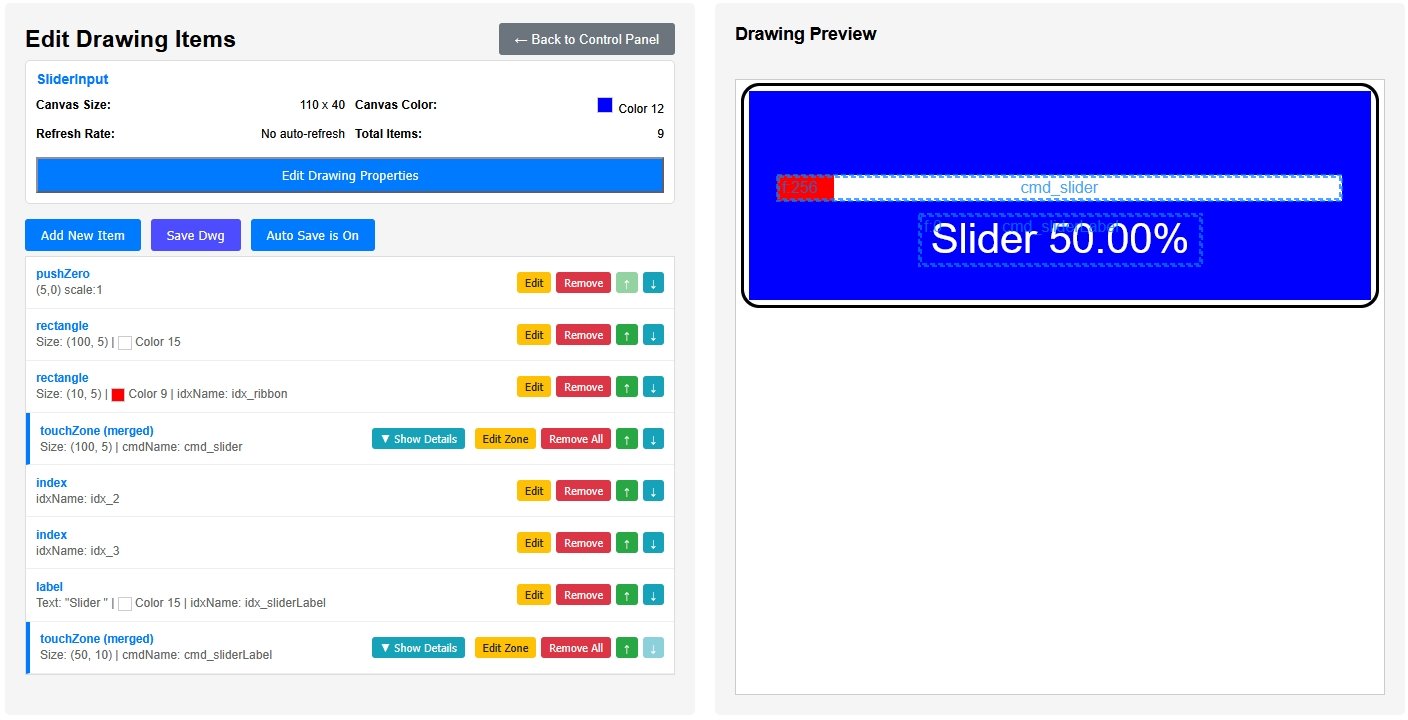
Add another Label, indexed, with 2 decimal places and some
initial Value, but with no Text or Units. The color and position is
not important as this label will be hidden in a later step.
The
idx is named idx_hidden as it will be the hidden label
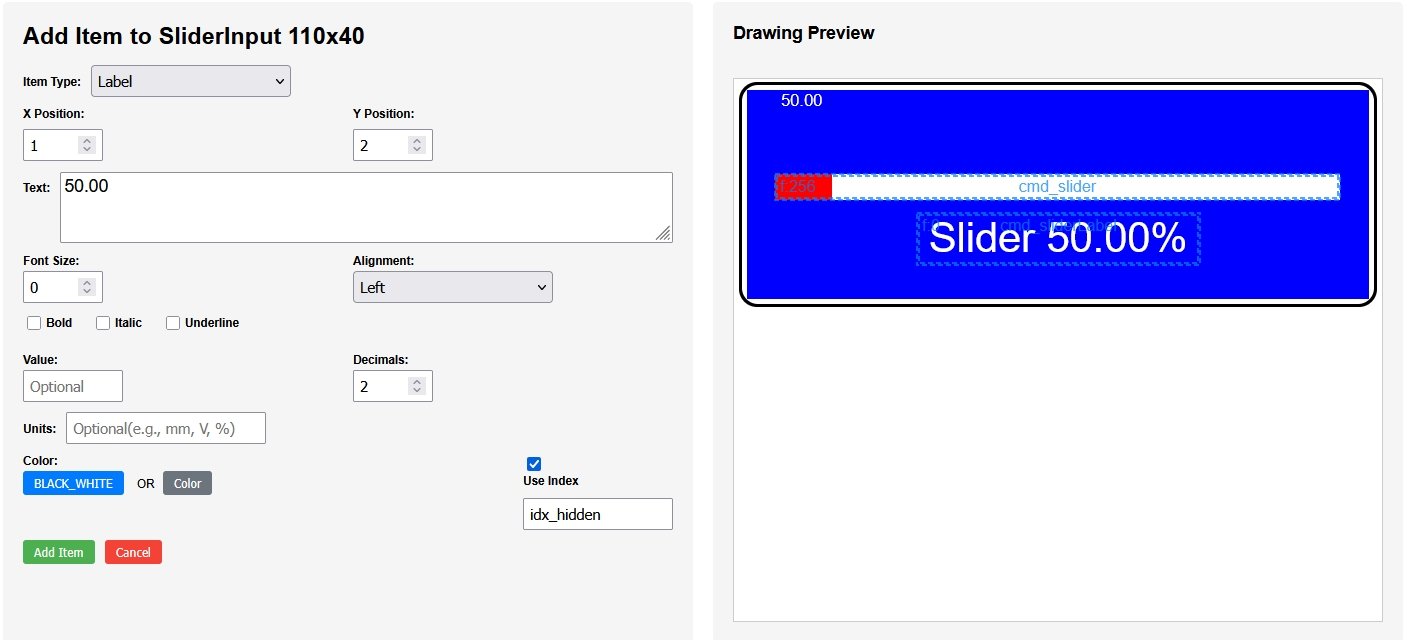
Open the Show Details of the touchZone that encloses the Slider..% label, and click on Add touchActionInput.
Change the Prompt Text to something suitable and select idx_hidden 50.00 from the drop down list of Indexed Labels

Choose a suitable color for the prompt text and background. You can then click on the Slider % touchZone in the preview to see the touchActionInput in action.
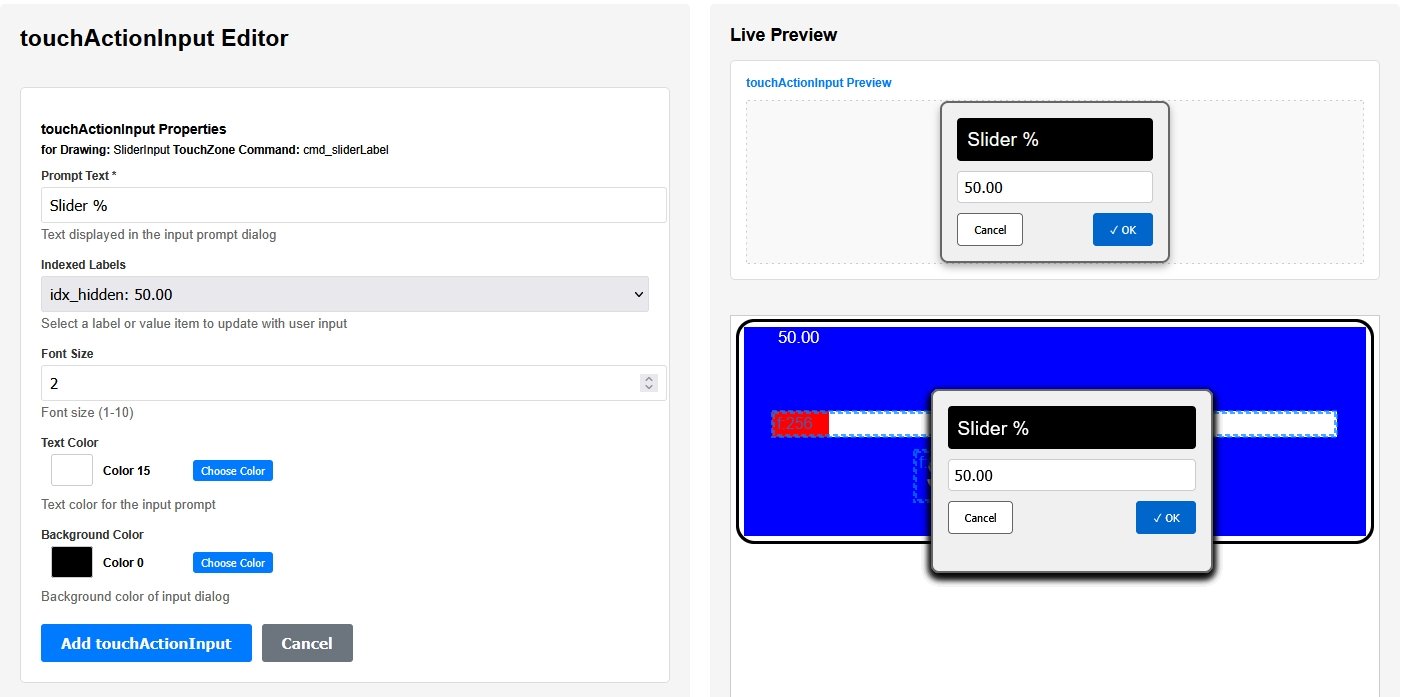
Click Add touchActionInput to accept these edits.
Add a hide Item. You can click Show for visible items to make them flash.
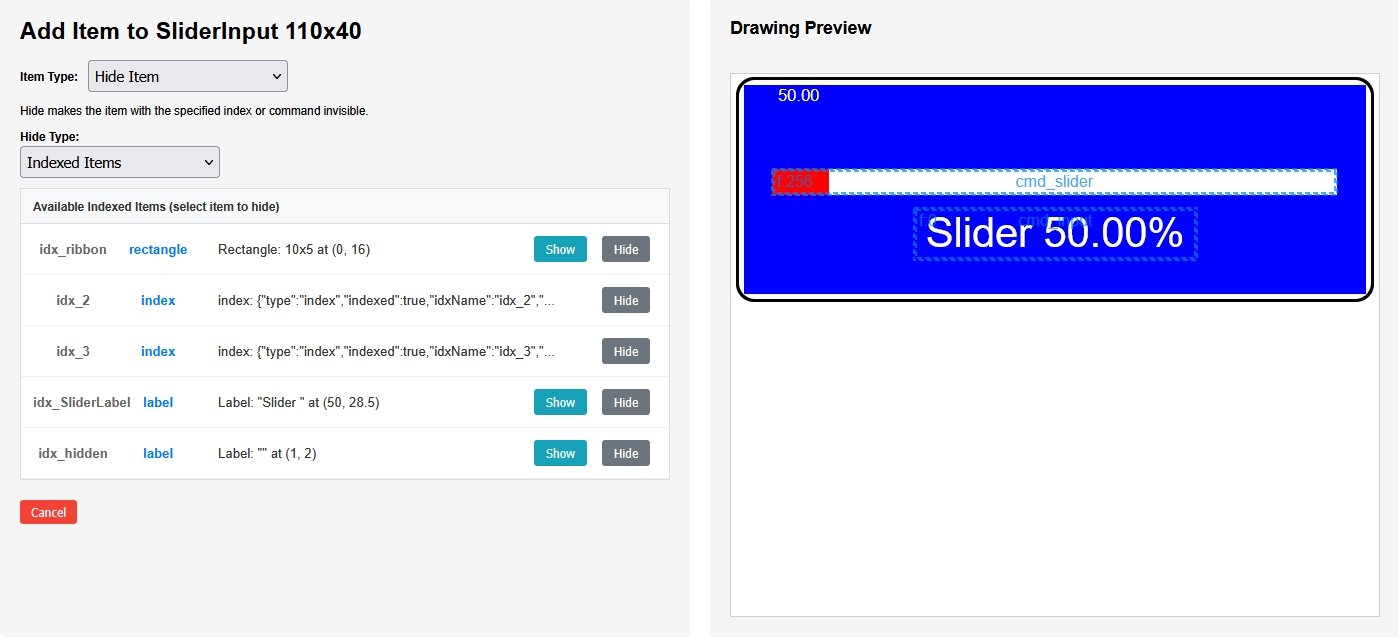
Click Hide for idx_hidden to hide the 50.00 label
that is used for the touchActionInput.
Go back to the
Control Panel and use the Arduino Export to generate the Arduino
sketch, SliderInput_serial.zip
The completed sketch is in SliderInput_serial.zip.
Open
it in Arduino and add the SliderControls.cpp / .h files from the
previous tutorial.
Edit SliderControls to add a setPosition(char* str) method
that accepts the user's input and converts it to a slider position
and checks for errors.
The SafeString library is used to a) safely
copy the first 20 chars of the edited text and b) convert it to a
float.
#include <SafeString.h>
#include <pfodDebugPtr.h>
#define DEBUG
static Print* debugPtr = NULL; // local to this file
float position;
cSF(sfPosition, 20);
void setPosition(char* str) {
#ifdef DEBUG
debugPtr = getDebugPtr();
#endif
sfPosition.clear();
sfPosition.readFrom(str); // reads at most 20 chars from the edited text
if (sfPosition.toFloat(position)) { // if it is a valid float, limit it
if (position < 0) { position = 0; }
if (position > 100) { position = 100; }
} else {
// not a valid float. print/send an error.
if (debugPtr) {
debugPtr->print(sfPosition);
debugPtr->println(" is not a valid float.");
}
}
}
In Dwg_SliderInput.cpp add the function calls to SliderControls
#include "SliderControls.h"
. . .
bool Dwg_SliderInput::processDwgCmds() {
if (!(*(parserPtr->getDwgCmd()))) { // ==> getDwgCmd returned pointer to empty string
return false; // not dwg cmd, not handled
}
if (parserPtr->dwgCmdEquals(cmd_slider)) { // handle touchZone cmd_slider
setPosition(parserPtr->getTouchedCol());
sendUpdate();
return true;
}
if (parserPtr->dwgCmdEquals(cmd_input)) { // handle touchZone cmd_input
setPosition((char*)parserPtr->getEditedText());
sendUpdate();
return true;
}
return false; // not handled
}
. . .
void Dwg_SliderInput::sendIndexedItems() {
dwgsPtr->rectangle().filled().idx(idx_ribbon).color(dwgsPtr->RED).size(getPosition(),5).offset(0,16).send();
dwgsPtr->label().idx(idx_sliderLabel).color(dwgsPtr->WHITE).text("Slider ").fontSize(8).offset(50,28.5).center().units("%").decimals(2).value(getPosition()).send();
dwgsPtr->label().idx(idx_hidden).color(dwgsPtr->BLACK_WHITE).text("").offset(1,2).left().decimals(2).value(getPosition()).send();
}
In the previous tutorial, the slider position was an integer set
by the touch X position. Here the slider_percent will be a float that
can be set by either to touch X position or via the touchActionInput
dialog box.
The current value of the slider_percent is used to
a) set the
width of the slider RED indicator,
b) set the visible label
“Slider … %” and
c) set the numeric value of
the hidded label that the touchActionInput will display on
opening.
To collect the user's slider settings, edit the processDwgCmds() checks for the command contained in the cmd_slider variable which is the command sent by the slider touchZone and as in the previous tutorial, the position is set to the touchedCol. The command contained in the variable cmd_input is the command sent by the Slider .. % label touchZone after the touchActionInput dialog box has been OKed.
A typical command set when the touchActionInput dialog box is OK is
{A~c3`19`4`0~35.35}where the last field is the text the user entered. The pfodParser truncates the incoming msg at 255 chars. The Edited text is on the end of the incoming message and so is limited to less than 255 chars. See the pfodSpecification.pdf for more info on touchActionInput messages.
The touchActionInput dialog box does not do any validation. It is up to your Arduino code to do that. In SliderControls.cpp, the SafeString library is used to a) safely copy the first 20 chars of the edited text and b) convert it to a float.
If the user enters an invalid slider setting, it is helpful to display an error message to them.
Open pfodWebDesigner and copy SliderInput to SliderInputErr and edit it to add an indexed ErrMsg label
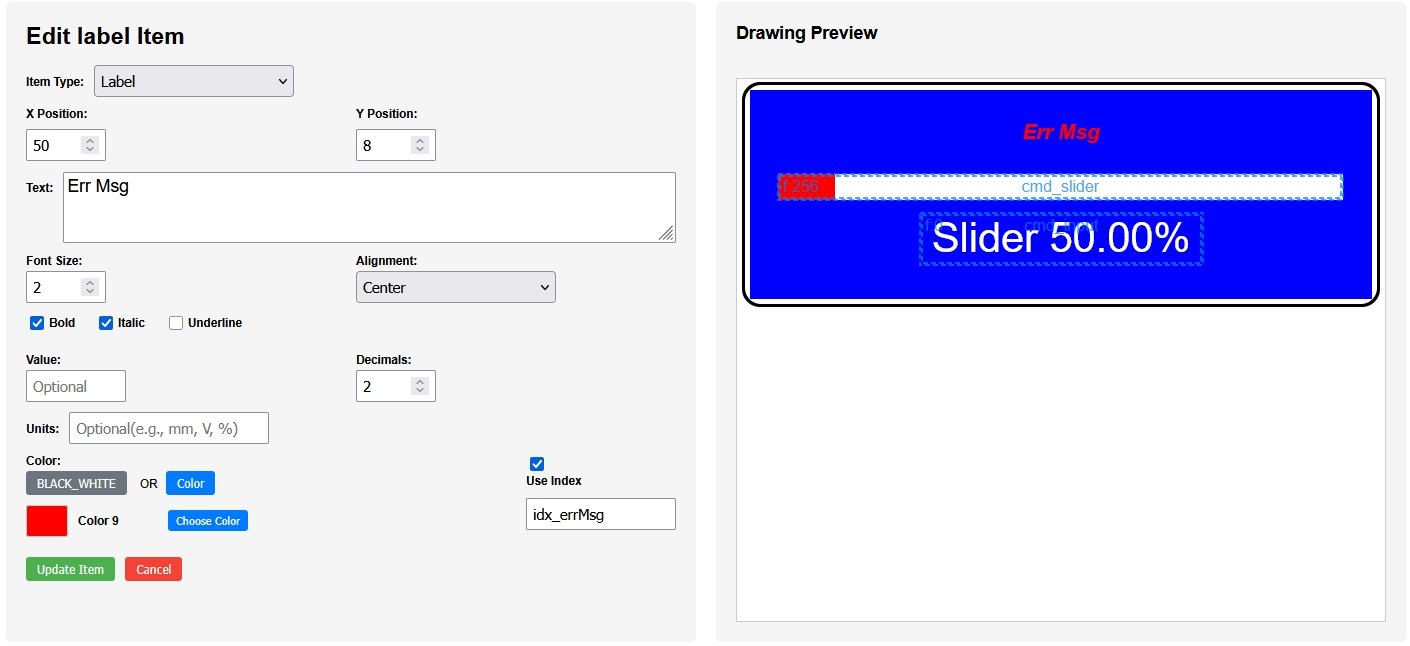
If there are no errors, the Arduino Code in SliderControls will set a empty message which make the message invisible.
When the user goes to correct an
error, the previous error message will still be displayed until the
pfodDevice responds.
To hide any existing error message, add a
touchAction to both touchZones to clear
the error msg.
That is replace idx_errMsg with an label
empty of text.
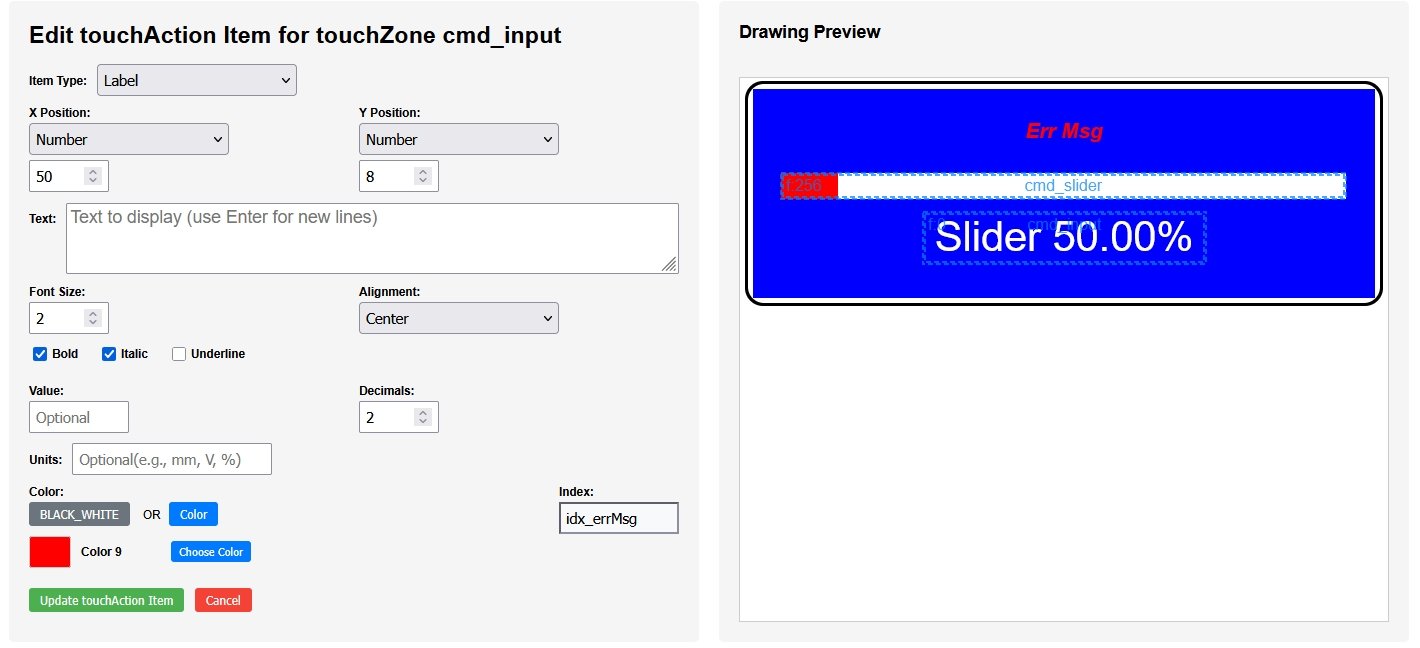
Go back to the Control Panel and use Arduino Export to generate the new code, SliderInputErr_serial.zip.
Copy over SliderControls and merge the changes in Dwg_SliderInput.cpp into Dwg_SliderInputErr.cpp. In the Dwg_SliderInputErr::sendIndexedItems() call getErrMsg() to display any errors.
void Dwg_SliderInputErr::sendIndexedItems() {
dwgsPtr->rectangle().filled().idx(idx_ribbon).color(dwgsPtr->RED).size(getPosition(),5).offset(0,16).send();
dwgsPtr->label().idx(idx_sliderLabel).color(dwgsPtr->WHITE).text("Slider ").fontSize(8).offset(50,28.5).center().units("%").decimals(2).value(getPosition()).send();
dwgsPtr->label().idx(idx_hidden).color(dwgsPtr->BLACK_WHITE).text("").offset(1,2).left().decimals(2).value(getPosition()).send();
dwgsPtr->label().idx(idx_errMsg).color(dwgsPtr->RED).text(getErrMsg().c_str()).fontSize(2).bold().italic().offset(50,8).center().decimals(2).send();
}Add the getErrMsg() method to SliderControls
cSF(sfErrMsg, 30);
SafeString& getErrMsg() {
return sfErrMsg;
}and update the sfErrMsg with any error message. See code in the completed sketch SliderInputErr_serial.zip
This page covered using a touchActionInput to allow the use to send text data to the pfodDevice (your microprocessor) . It showed how to add a hidden label to the drawing that does not display but which can be updated and provide the default value for the touchActionInput dialog box.
AndroidTM is a trademark of Google Inc. For use of the Arduino name see http://arduino.cc/en/Main/FAQ
The General Purpose Android/Arduino Control App.
pfodDevice™ and pfodApp™ are trade marks of Forward Computing and Control Pty. Ltd.
Contact Forward Computing and Control by
©Copyright 1996-2024 Forward Computing and Control Pty. Ltd.
ACN 003 669 994